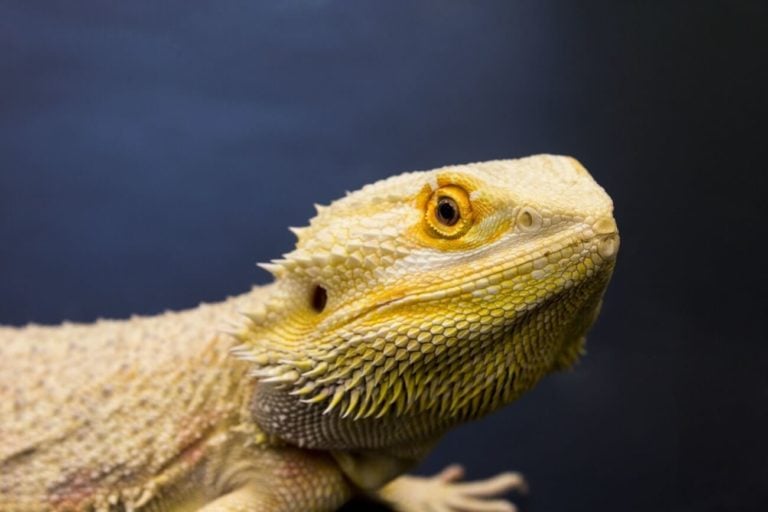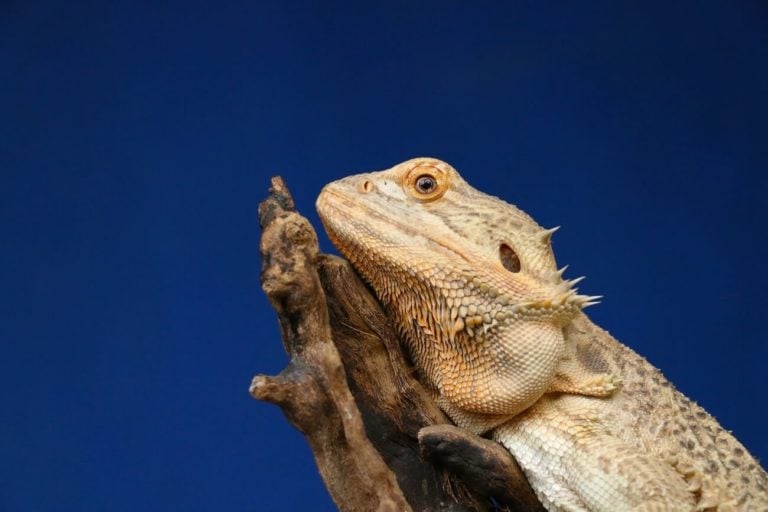Understanding what bearded dragons eat is a crucial part of your role as an owner. The right diet can make a massive impact on the overall health and happiness of these pet reptiles, so you want to get it right!
But with so many foods to choose from, coming up with the perfect bearded dragon diet can seem a bit overwhelming at first.
To make things easy, we created this resource to help you quickly see what foods you can feed your bearded dragon. Not only that, but we also show you how to adjust their diet as they get older.
Table of Contents
The Importance Of A Good Diet
Bearded dragons need good, nutritious diets in order to stay healthy and live quality lives (like any other pet). But a good diet does more than simply keep your bearded dragon healthy.
It helps keep their coloring vibrant, increases their activity level, and will help maximize their lifespan!
How We Structured This Guide
We understand that some people just want to know different types of foods that bearded dragons can eat so they can mix up their current diet a bit.
Because of that, we decided to put the lists first. Below you’ll see all the possible insects, vegetables, greens, and fruits beardies can eat. We also included a list of what they can’t eat as well.
After that, you’ll find detailed sections that explain the ideal bearded dragon diet. Here you can take the foods from the lists above, and put together a feeding plan that works for you. We also have information that covers how their diet will change as they get older.
We highly recommend reading those sections.
Having a list of what bearded dragons can eat is just one piece of the puzzle. You need to know the ratio of what kind of foods to feed them (how much of the diet should be insects instead of vegetables for example) if you want them to be truly healthy.
Alright! Without further delay, let’s jump into the guide.
Insects & Bugs
Bearded dragons are big fans of live insects, and you can either raise live insects yourself or purchase them from your local reptile store.
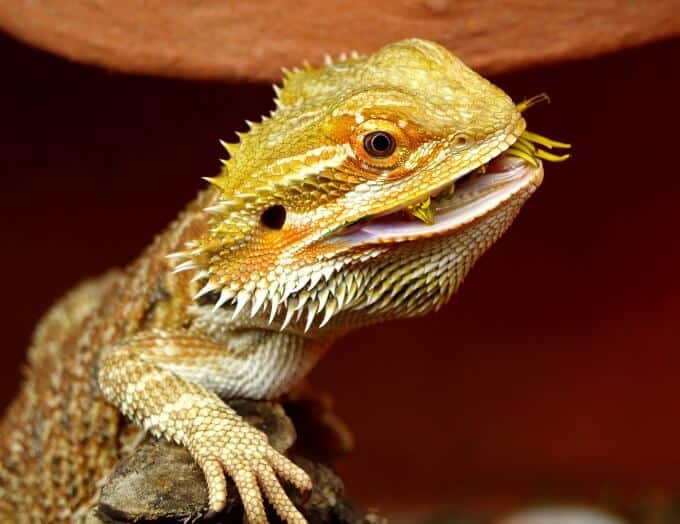
Expert Tip: You should not feed insects you find outside in your yard or garden or your beardie. These insects may contain pesticides, insecticides, or fertilizers that are toxic to bearded dragons.
It’s recommended that you feed your bearded dragon as many insects as it can eat in 15 minutes. Pick up all of the insects left over after that time, since remnant food can lead to overeating or insects burying themselves in your lizard’s substrate (causing problems later).
Crickets and Dubia roaches are two of the most popular insects to feed bearded dragons. Each insect has its own pros and cons:
Crickets have a softer shell and don’t bury themselves in the substrate immediately. However, crickets do jump (meaning they can escape easier), smell foul, and can carry parasites, which can cause health issues for your lizard. If you plan on breeding your own insects, crickets are also harder to breed.
Read this guide to learn how many crickets you should feed your beardie.
On the other hand, Dubia roaches don’t smell foul, can’t jump, and don’t carry parasites. They are also easy to breed and live longer than crickets do.
However, Dubia roaches stand still or hide, which make them more challenging for bearded dragons to find. The Dubia roach’s hard shell also makes them more challenging to dust before feeding. They also take longer to sort by size before feeding them to your lizard.
Here’s the full list of insects that you can include in a bearded dragon diet:
- Crickets
- Grasshoppers
- Kingworms
- Earthworms
- Dubia roaches
- Spiders
- Silkworms
- Superworms
- Hornworms
- Moths
- Phoenix worms
- Slugs
- Wax worms
- Mealworms
- Black soldier fly larvae
- Butter worms
- Cockroaches
- Redworms
- Locusts
Vegetables & Greens
Approximately 80-90% of the plant matter you feed your beardie should be vegetables and greens. Any dark leafy greens can make up the majority of your lizard’s vegetable content. It’s recommended that you avoid light greens because they are high in fiber and nutrient-poor.
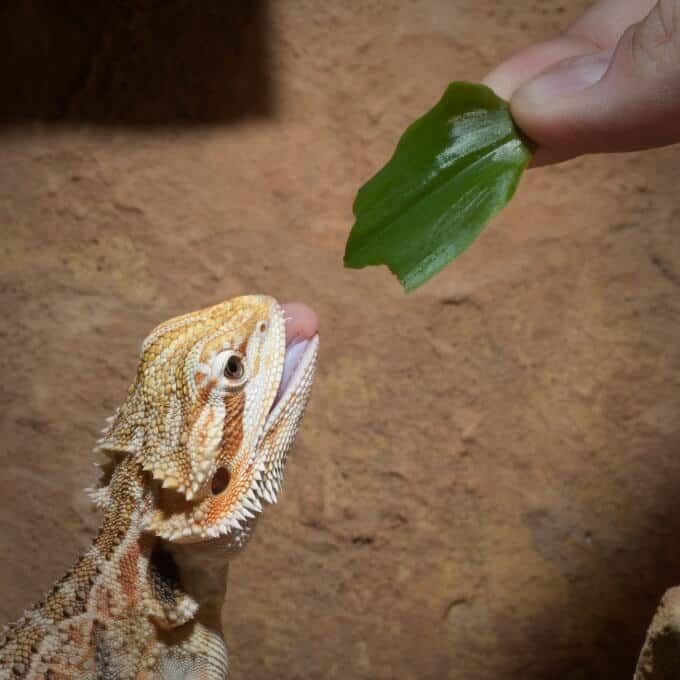
You can feed your beardie cooked or raw vegetables. We tend to recommend raw vegetables, since they retain more nutrients than cooked vegetables.
Expert Tip: Wash vegetables before feeding them to your lizard. Chop vegetables and mix them together to prevent your beardie from selecting and eating only their favorite foods.
You should feed your beardies beet greens, Swiss chard, and spinach sparingly. This is because they possess oxalates that can build calcium and other trace minerals, preventing them from being absorbed into the body (which can result in nutrient deficiencies).
Kale, cabbage, and mustard greens should also be fed sparingly because they possess goitrogens, which are substances that suppress the functioning of the thyroid gland. Feeding these vegetables too often can lead to hypothyroidism.
Here’s the massive list of what vegetable and greens you can feed your bearded dragon:
- Sprouts
- Escarole
- Watercress
- Parsley
- Carnations
- Okra
- Sweet potato
- Green beans
- Kale
- Hibiscus
- Carrots
- Collard greens
- Broccoli
- Asparagus
- Zucchini
- Artichoke hearts
- Cucumber
- Cabbage
- Nasturtiums
- Geraniums
- Kohlrabi
- Cooked lentils
- Various types of squash
- Celery
- Peas
- Swiss chard
- Beet greens
- Corn
- Endive
- Mushrooms
- Bok choy
- Clover
- Pumpkin
- Parsnips
- Bell peppers
- Radicchio
- Savory.
- Cilantro
- Mustard greens
- Turnip greens
- Chicory
- Dandelion
- Roses
Fruits
Fruits should be 10-20% of the plant matter that you feed your bearded dragon. These reptiles may enjoy eating fruits, but they aren’t very rich in nutrients, which is why they shouldn’t comprise much of their diet. Fruits can be served on top of vegetables and greens as a dressing.
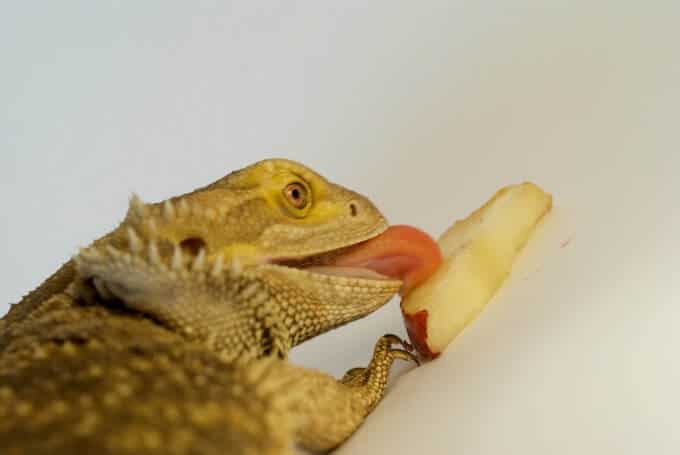
Wash fruits before feeding them to your beardie. Remember that some fruits go bad quickly, so always check fruit thoroughly before offering it to your lizard.
Here’s a list of fruits that your bearded dragon can eat:
- Strawberries
- Grapefruit
- Nectarines
- Apricots
- Tomatoes
- Pears
- Grapes
- Bananas with or without the peels still on
- Melons
- Blueberries
- Pineapples
- Guavas
- Plums
- Prunes
- Star fruit
- Blackberries
- Peaches
- Mangoes
- Chayote
- Kiwis
- Cranberries
- Cherries
- Watermelon
- Dates
- Raspberries
- Papayas
- Apples
- Raisins
- Figs
Foods To Avoid
Knowing what foods you can’t feed your beardie is incredibly important, and there are a number of foods to be aware of. Some of these food items simply aren’t healthy for bearded dragons, while others can cause serious medical issues (or even death) if your lizard ingests them.
For example, you shouldn’t feed your bearded dragon any insects that glow in the dark, such as fireflies or lightning bugs. The chemical that makes these insects glow in the dark is toxic to bearded dragons. Avocados are also toxic to beardies.
Expert Tip: If your bearded dragon gets sick, isn’t eating, or ingests something on this list, you should consult with your veterinarian. If you aren’t sure whether a food is safe or toxic to your beardie, avoid feeding it until you can talk with them about it as well.
Some foods to avoid feeding your bearded dragon include:
- Scorpions, bees, wasps, and other venomous insects
- Elder bugs
- Avocados
- Lettuce (because it has very little nutritional value and is mostly water)
- Oak
- Daffodil
- Rhubarb
- Fish and seafood
- Ivy
- Horse chestnut
- Crocus
- Buttercup
- Fireflies, lightning bugs, and other insects that glow in the dark
- Holly
- Poppies
There’s a misconception among some that eggs are a food to avoid, but bearded dragons can eat eggs as well.
General Food Principles To Follow
Bearded dragons are omnivores which means that they eat both plant and animal-based foods.
In the wild, bearded dragons eat a wide variety of insects, fruits, and vegetables (we dig into each of those a bit later on). While we may not be able to fully replicate the diet of bearded dragons living in the wild, you’ll want to replicate the lizard’s natural diet as closely as you can for your pet bearded dragon.
Like other reptiles, a bearded dragon’s dietary needs will change as it grows. For instance, a young beardie requires more meat in its diet since it needs fats and protein to help it reach its full-grown size. Once they reach maturity, a bearded dragon will need to eat more vegetables in order to help them stay healthy.
Feeding Tips
You may want to feed your beardie using a small dish or bowl. You shouldn’t feed your lizard on loose substrate, since it can be accidentally ingested while eating (this happens more often with young bearded dragons). While older beardies can more easily digest a little loose substrate if they accidentally ingest it, loose substrate can cause serious health issues.
Turn on your beardie’s light about 30-60 minutes before mealtimes since it will warm them up and stimulate their appetite.
Leave your beardie’s light on for at least 30-60 minutes after mealtime as well. Your bearded dragon needs to be warm in order to properly digest their food. If it’s not warm while they’re digesting, your beardie’s body can’t absorb the nutrients it needs (and they could suffer from impaction).
Water & Hydration
While bearded dragons naturally live in hot and dry climates, it’s still very important for them to stay hydrated. A bearded dragon will get most of their water through eating vegetables. Because of their natural desert environment, bearded dragons kept as pets may not recognize a standing source of water, such as a water bowl as a source of water. However, you should provide your lizard with a water dish anyway.
Expert Tip: Don’t be surprised if you see your beardie soaking in their water dish rather than drinking from it. Soaking is a natural behavior for bearded dragons and it actually helps them with digestion. You’ll want to change your bearded dragon’s water frequently though, because it’s normal for them to urinate or defecate in it while they are soaking.
Another way you can help your bearded dragon stay hydrated is by misting them! You can mist them once or twice a day with a spray bottle. Misting your beardie with a spray bottle simulates rain or dew that occurs in the wild (bearded dragons often drink dew drops in their natural habitat).
Misting your beardie when they’re shedding moisturizes their skin and helps them shed more easily.
Adult Bearded Dragon Diet Tips
There are a few things you’ll need to remember when it comes to an adult bearded dragon diet (defined as 18 months or older).
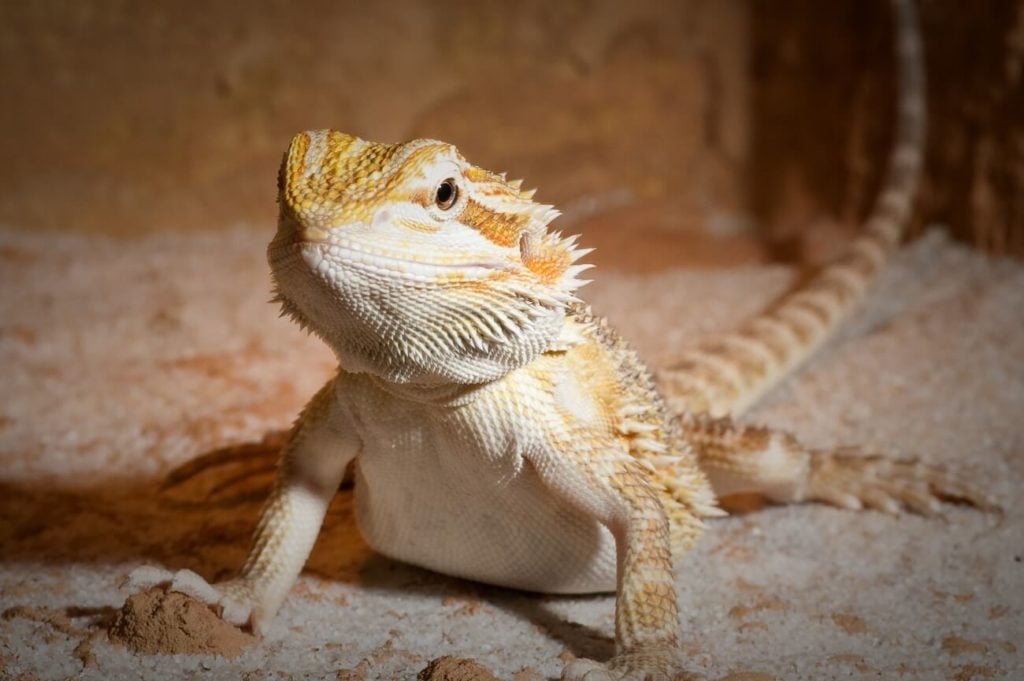
Adult bearded dragons have reached maturity, and, as a result will not need as much protein as baby and juvenile lizards. At this stage, your adult bearded dragon’s diet should consist of 80% vegetables and greens and 20% insects. Feeding your adult bearded dragon too many insects will lead to obesity, since they don’t get as much exercise as beardies in the wild.
You only need to feed your adult bearded dragon once each day. Calcium deficiency can be a problem for reptiles, which can result in metabolic bone disease. Therefore, dusting your lizard’s food with a calcium supplement is an important aspect of their diet.
It is recommended that you lightly sprinkle your bearded dragon’s food with a calcium supplement not containing vitamin D3 two to three times each week. You should sprinkle your lizard’s food with a calcium supplement containing vitamin D3 an additional two to three times per week.
Once a week, you should dust their food with a general reptile mineral supplement. It is recommended that you do not mix supplements; sprinkle one type of supplement on your beardie’s food one day and another supplement on your lizard’s food the next day.
You can dust your beardie’s live insects or vegetation. To dust your bearded dragon’s live insects, place them in a container and sprinkle the calcium supplement or multivitamin onto the insects. Gently shake the container around a little to cover the insects in the supplement. Don’t shake the container too vigorously, though. You don’t want to accidentally kill any of the insects.
Expert Tip: It is important to monitor your lizard’s phosphorus-calcium ratio. If your beardie’s diet contains too much phosphorus, it may have difficulty absorbing calcium. Fruits and vegetables contain a lot of phosphorus, so most lizards receive enough phosphorus through the food they eat. You may want to consider using a multivitamin that doesn’t contain phosphorus for this reason.
Dust your lizard’s supplements on small amounts of food and offer this food first so you can be sure the supplements are actually being eaten. Inappropriate supplementation is a common problem for beardies in captivity. Always consult your veterinarian about which supplements are best for your bearded dragon.
Baby Bearded Dragon Diet Tips
Bearded dragons between birth and five months old are considered babies. A baby bearded dragon diet should consist of more insects than you feed older beardies because they’re rapidly growing.
Baby bearded dragons should eat a diet containing 80% insects and 20% vegetation. They also need to eat smaller meals more times a day.
Feed baby lizards insects three times a day, and allow them to eat as many insects as they want in a 10-15 minute period each time. Baby beardies can eat up to 60 insects each day. If your lizard stops eating during the insect-eating period, it means they’re full.
Clean up any leftover insects. You can leave some finely chopped vegetation in your beardie’s tank, and it will snack on them between mealtimes if it gets hungry.
It is recommended that you dust your baby beardie’s food with a calcium supplement once a day for five days each week. On the remaining two days, dust your bearded dragon’s food with the multivitamin.
Juvenile Bearded Dragon Diet Tips
This species is considered to be a juvenile when it is between the ages of five and 17 months old. When they are this age, a juvenile bearded dragon’s diet should consist of 50% insects and 50% vegetation. You can feed juveniles two to three times each day.
Juvenile bearded dragons continue to need more calcium than adults, but they no longer need as much as babies do. It’s recommended that you dust your juvenile bearded dragon’s food with a calcium supplement three to four times each week.
A bearded dragon’s juvenile period can be a tricky time in terms of diet because it’s an in-between phase. If you have any questions about your bearded dragon’s diet or supplementation needs, you should always consult your vet for advice.
Closing Thoughts
A healthy bearded dragon diet keeps things simple. It takes what foods they can eat, factors in the appropriate ratio of food-type, and goes from there!
While it might seem complicated at first, you’ll quickly come up with a rhythm when it comes to feeding your beardie. The whole process will become second nature!
If there’s anything you think we can add to make this guide more helpful, don’t hesitate to let us know. We’re always looking for ways to improve the resources on our site!

